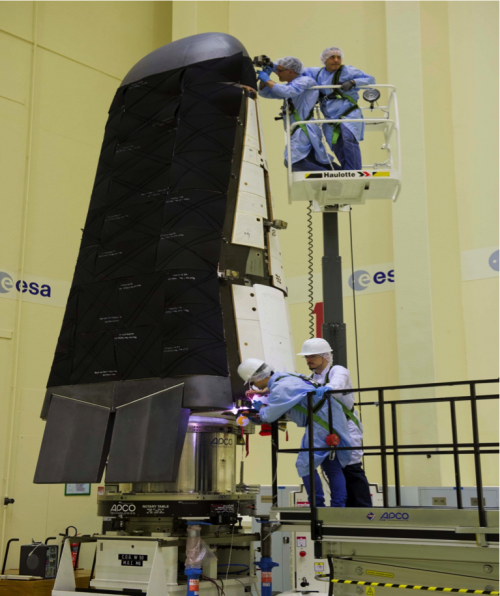![From the European Space Agency (ESA): "[The IXV] will be launched by ESA in 2014 on Vega, Europe’s new small launcher, into a suborbital path, from Europe’s Spaceport in French Guiana. After being launched into space, IXV will return to Earth as if from a low-orbit mission, testing brand-new European atmospheric reentry technologies during its hypersonic and supersonic flight phases." Image Credit: ESA–J. Huart](https://www.americaspace.com/wp-content/uploads/2014/07/Artist_s_view_of_the_IXV_mission.jpg)
The European Space Agency (ESA) announced this week that its Intermediate eXperimental Vehicle (IXV) is in its final testing phase in anticipation of its rocket-powered November flight. The flight is meant to investigate the conditions the vehicle will encounter during atmospheric reentry, and to test critical systems needed to return Europe’s future automated reentry vehicles. In addition, several U.S. spaceplanes—including Dream Chaser and the X-37B—have passed milestones in development and in flight.
The IXV spaceplane will be lofted aboard a Vega rocket from a launch site at the Guiana Space Centre in French Guiana. Previous Vega launches have taken payloads into a polar orbit, but according to the ESA this launch will see Vega head east as it takes the IXV on a suborbital trajectory. Outfitted with hundreds of sensors and an infrared camera, the spacecraft will reenter over the Pacific Ocean and will be recovered by a ship.

At present time, the IXV is being tested to check that it will withstand launch and separation, which is especially demanding on a spacecraft. At a size of approximately 1,800 kilograms (4,000 pounds), the vehicle is nearly at the weight limit for the Vega launch vehicle and has been described as a “tight fit” for the launcher’s fairing.
This test mission is essential in that it will test technologies in a manner that cannot be replicated on Earth. Jose Longo, ESA’s head of aerothermodynamics, underscored that sentiment:
“The technical advancements that have been made since the first experiments with our Atmospheric Reentry Demonstrator in 1996 are huge. This is the first flight demonstration of features such as highly advanced thermal structures: thrusters and flaps that are part of the control system, and the 300 sensors and infrared camera to map the heating all along the spacecraft from the nose to the flaps. These things just cannot be tested in the same way in laboratories,” Longo related.
The IXV hearkens back to a canceled spaceplane CNES (France’s space agency) and the ESA were developing throughout the 1980s and early 1990s. Hermes, described as Europe’s answer to the U.S. space shuttle, was intended to be launched on an Ariane rocket into low-Earth orbit with the objective of rendezvousing with space stations and deploying payloads. However, as costs skyrocketed and the size of the plane grew, the project never saw the light of day. A short history of Hermes is detailed in a previous AmericaSpace article by this author.
The IXV announcement comes days after the Sierra Nevada Corporation (SNC) stated their spaceplane, Dream Chaser, had passed a NASA Commercial Crew milestone. On July 8, SNC announced it had “completed a major Main Propulsion System (MPS) and Reaction Control System (RCS) risk reduction milestone for the Dream Chaser Space System, maturing the design of each system close to Critical Design Review (CDR).” SNC is one of three private companies currently developing spacecraft to shuttle crews into low-Earth orbit (the other two are Boeing and SpaceX, which are respectively developing the CST-100 capsule and the Dragon spacecraft).
In military spaceplane news, the X-37B spacecraft, manufactured by Boeing and used by the United States Air Force, is coming up on nearly 600 days in space (at present time, it has clocked 585 days in orbit). This “secret” spaceplane launched from Cape Canaveral Air Force Station aboard an Atlas V launch vehicle on Dec. 11, 2012.
A previous AmericaSpace article written by Ben Evans during that time stated: “The X-37B’s deployable solar array enables it to ‘loiter’ in low-Earth orbit for far longer than the shuttle could ever achieve. With two missions behind it—the first of which lasted 224 days, the second 469—it remains to be seen how long OTV-3 will remain aloft.” An article published this week on Space.com detailed the U.S. military’s effort to develop a spaceplane that could launch payloads.
While the remaining space shuttles may now be museum pieces, efforts by the ESA, Sierra Nevada, and the U.S. military have shown that spaceplanes are not just things of the past. In November, eyes will again turn skyward as the IXV makes its test voyage.
Want to keep up-to-date with all things space? Be sure to “Like” AmericaSpace on Facebook and follow us on Twitter: @AmericaSpace



